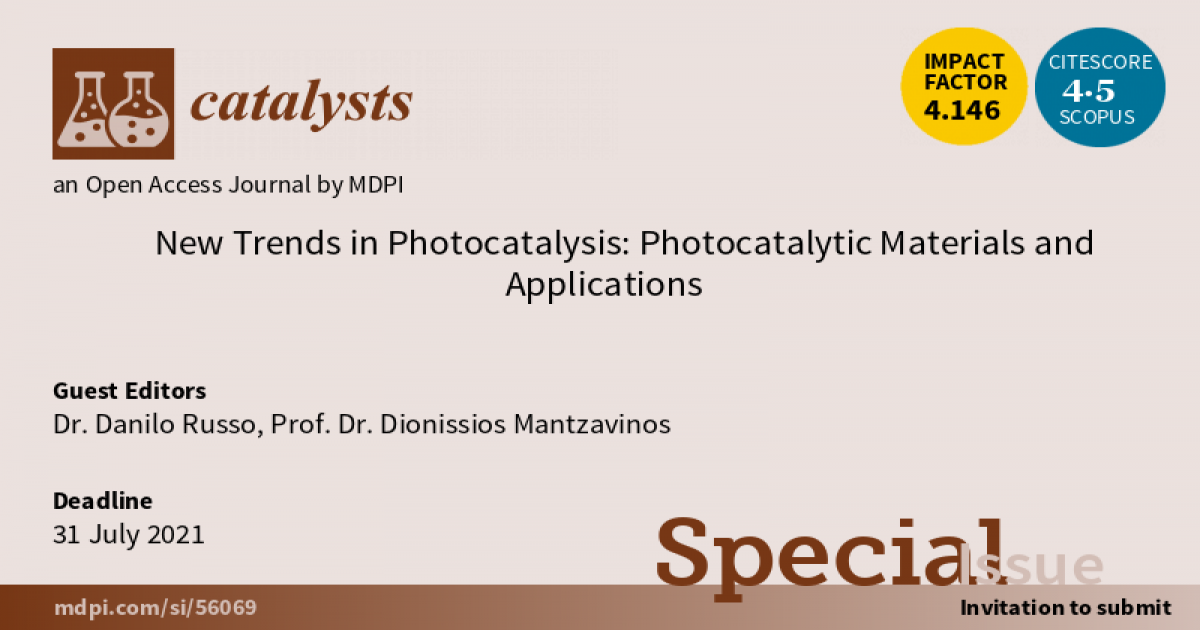New Trends in Photocatalysis: Photocatalytic Materials and Applications
A special issue of Catalysts (ISSN 2073-4344). This special issue belongs to the section "Photocatalysis".
Deadline for manuscript submissions: closed (10 January 2022) | Viewed by 25348

Special Issue Editors
Interests: advanced oxidation processes of micropollutants in aqueous solution; kinetic modeling; heterogeneous photocatalysis; continuous-flow microreactors
Special Issues, Collections and Topics in MDPI journals
Interests: wastewater treatment technologies; advanced oxidation processes (AOPs) (process integration, kinetics and mechanisms, transformation byproducts and properties and reaction networks, modeling and optimization, scale-up); industrial wastewater treatment and valorization (olive oil production, edible olives, textiles, cotton processing, wineries, leachates); emerging and persistent micro-pollutants in the water cycle (pharmaceuticals, endocrine disruptors, pesticides); inactivation of waterborne pathogens
Special Issues, Collections and Topics in MDPI journals
Special Issue Information
Dear Colleagues,
Photocatalysts represent a class of important materials for a wide range of processes, from the production of new pharmaceuticals to environmental applications. As a result, the number of studies investigating photocatalytic materials is steadily increasing, also showing an interesting level of interdisciplinary collaboration between chemists, engineers, and materials scientists. Recent trends focus on the design of catalysts at different hierarchical levels, ranging from molecular to plant-scale, within the more general framework of sustainability challenges and process intensification. Potential topics of interest for this Special Issue include, but are not limited to, the following aspects:
- Synthesis and characterization of novel photocatalysts
- Intensification of photocatalytic processes for the production of functional molecules
- Applications of photocatalysts in wastewater and air treatment
- Photocatalytic materials to address specific sustainability challenges
- Photocatalytic reactor and plant design
- Critical and perspective reviews on proposed aspects of photocatalysis
Dr. Danilo Russo
Prof. Dr. Dionissios Mantzavinos
Guest Editors
Manuscript Submission Information
Manuscripts should be submitted online at www.mdpi.com by registering and logging in to this website. Once you are registered, click here to go to the submission form. Manuscripts can be submitted until the deadline. All submissions that pass pre-check are peer-reviewed. Accepted papers will be published continuously in the journal (as soon as accepted) and will be listed together on the special issue website. Research articles, review articles as well as short communications are invited. For planned papers, a title and short abstract (about 100 words) can be sent to the Editorial Office for announcement on this website.
Submitted manuscripts should not have been published previously, nor be under consideration for publication elsewhere (except conference proceedings papers). All manuscripts are thoroughly refereed through a single-blind peer-review process. A guide for authors and other relevant information for submission of manuscripts is available on the Instructions for Authors page. Catalysts is an international peer-reviewed open access monthly journal published by MDPI.
Please visit the Instructions for Authors page before submitting a manuscript. The Article Processing Charge (APC) for publication in this open access journal is 2200 CHF (Swiss Francs). Submitted papers should be well formatted and use good English. Authors may use MDPI's English editing service prior to publication or during author revisions.
Keywords
- photocatalysts
- photocatalysis
- sustainability
- material design
- process intensification
- environmental
Benefits of Publishing in a Special Issue
- Ease of navigation: Grouping papers by topic helps scholars navigate broad scope journals more efficiently.
- Greater discoverability: Special Issues support the reach and impact of scientific research. Articles in Special Issues are more discoverable and cited more frequently.
- Expansion of research network: Special Issues facilitate connections among authors, fostering scientific collaborations.
- External promotion: Articles in Special Issues are often promoted through the journal's social media, increasing their visibility.
- e-Book format: Special Issues with more than 10 articles can be published as dedicated e-books, ensuring wide and rapid dissemination.
Further information on MDPI's Special Issue polices can be found here.






